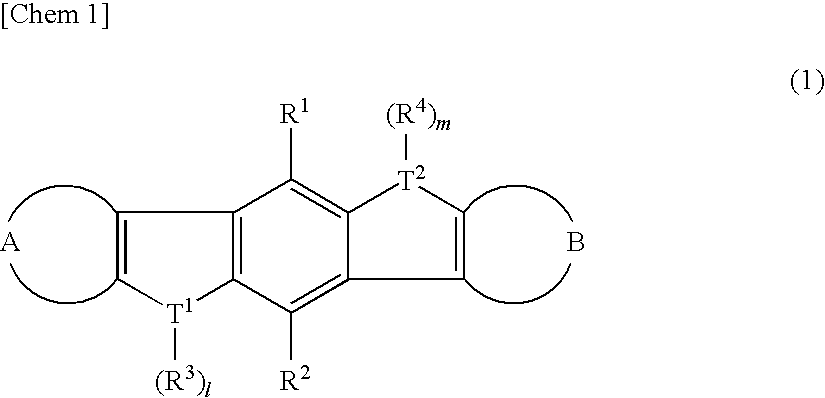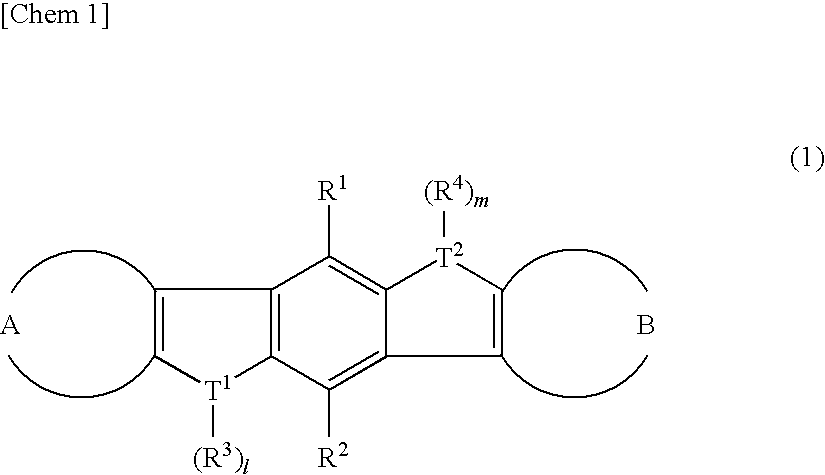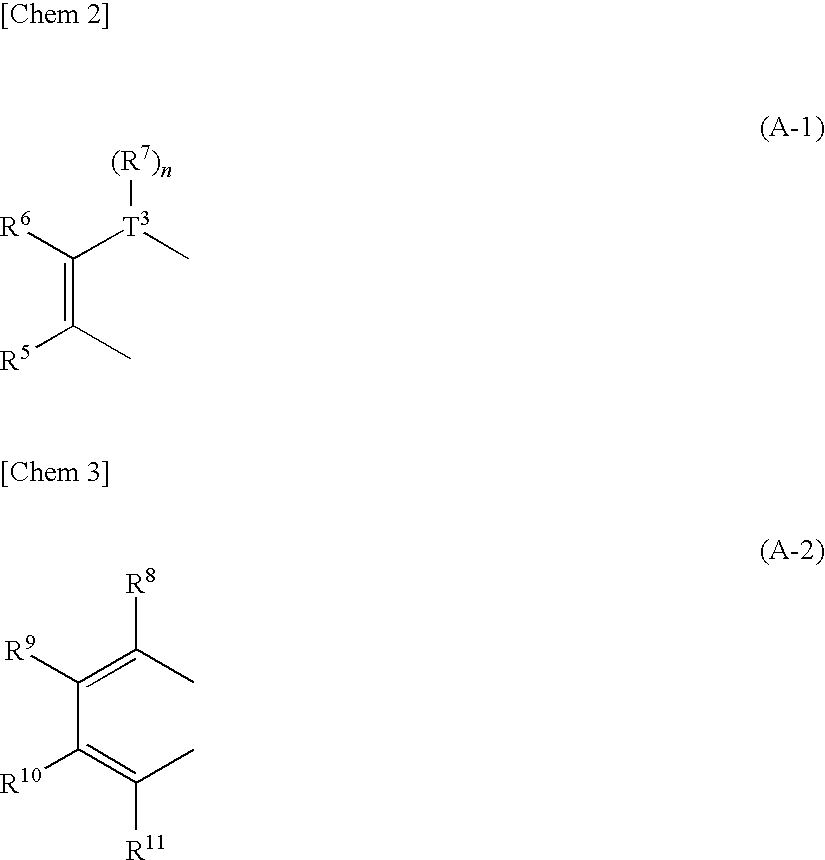Heteroacene derivative, tetrahaloterphenyl derivative, and processes for producing the same
a technology of tetrahaloterphenyl and acene, which is applied in the field of tetrahaloterphenyl derivatives and processes for producing the same, can solve the problems of difficult to form the active phase low performance of organic semiconductor devices, and difficulty in the application of coating processes from processing and economic viewpoints. achieve excellent oxidation resistan
- Summary
- Abstract
- Description
- Claims
- Application Information
AI Technical Summary
Benefits of technology
Problems solved by technology
Method used
Image
Examples
synthetic example 1
Synthesis of 1,4-Dibromo-2,5-diiodobenzene)
[0124]1,4-Dibromo-2,5-diiodobenzene was synthesized with reference to the method described in Journal of American Chemical Society, 1997, vol. 119, pp. 4578-4593.
[0125]To a 1 L three-necked flask fitted with a mechanical stirrer were added 16.7 g (73.0 mmol) of periodic acid and 525 ml of sulfuric acid. After periodic acid was dissolved, 36.4 g (219 mmol) of potassium iodide was added portionwise. The content was cooled to a temperature of −30° C. and 34.5 g (146 mmol) of 1,4-dibromobenzene was added over a period of 5 minutes. The resulting mixture was stirred at −25° C. for 36 hours. After the reaction mixture was poured into ice (2 kg), the whole was filtrated and a solid was taken out. The solid was dissolved in chloroform, the solution was washed with a 5% aqueous sodium hydroxide solution and water, and the organic phase was dried over anhydrous magnesium sulfate. After concentration under reduced pressure, the residue was recrystalli...
synthetic example 2
Synthesis of 2-Phenyl-5-bromo-4-biphenylboronic Acid
1) Synthesis of 1,2-Dibromo-4,5-diiodobenzene
[0128]1,2-Dibromo-4,5-diiodobenzene was synthesized in accordance with “Synlett”, 2003, pp. 29-34.
[0129]To a 1 L three-necked flask fitted with a mechanical stirrer were added 36.9 g (162 mmol) of periodic acid and 150 ml of sulfuric acid. After periodic acid was dissolved, 80.7 g (486 mmol) of potassium iodide was added portionwise. The content was cooled to a temperature of 0° C. and 75.0 g (318 mmol) of 1,2-dibromobenzene was added. The resulting mixture was stirred at 0° C. for 30 minutes. After the reaction mixture was poured into ice, the whole was filtrated and a solid was taken out. The solid was recrystallized twice from THF / methanol to obtain white crystals (76.2 g, yield 49%).
[0130]1H-NMR (CDCl3, 21° C.) δ=8.03 (s, 2H).
[0131]From the 1H-NMR measurement, it was confirmed that 1,2-dibromo-4,5-diiodobenzene was obtained.
2) Synthesis of 1,2-Dibromo-4,5-diphenylbenzene
[0132]To a 20...
synthetic example 3
Synthesis of 2-Bromo-3-iodonaphthalene
[0137]2-Bromo-3-iodonaphthalene was synthesized with reference to the method described in Synthetic Communications, 2003, vol. 33, pp. 2751-2756. A starting material, 2-bromo-bis(hexachlorocyclopentadiene)-naphthalene was purchased from Sigma-Aldrich and used as it was.
[0138]To a 500 ml three-necked flask reaction vessel were added under a nitrogen atmosphere 200 ml of methanesulfonic acid and 1.31 g (5.74 mmol) of orthoperiodic acid. After 30 minutes of stirring, 4.36 g (17.2 mmol) of iodine was added thereto. After the mixture was stirred for 2 hours, 30.1 g (40.0 mmol) of 2-bromo-bis(hexachlorocyclopentadiene)naphthalene was added portionwise. The mixture was stirred at 30° C. for 3 days. The reaction mixture was poured into ice water and the formed solid was filtrated. The solid was further washed with water and dried under reduced pressure to obtain a white powder of 2-bromo-3-iodo-bis(hexachlorocyclopentadiene)naphthalene (34.8 g, yield 99...
PUM
| Property | Measurement | Unit |
|---|---|---|
| temperature | aaaaa | aaaaa |
| temperature | aaaaa | aaaaa |
| temperature | aaaaa | aaaaa |
Abstract
Description
Claims
Application Information
 Login to View More
Login to View More - R&D
- Intellectual Property
- Life Sciences
- Materials
- Tech Scout
- Unparalleled Data Quality
- Higher Quality Content
- 60% Fewer Hallucinations
Browse by: Latest US Patents, China's latest patents, Technical Efficacy Thesaurus, Application Domain, Technology Topic, Popular Technical Reports.
© 2025 PatSnap. All rights reserved.Legal|Privacy policy|Modern Slavery Act Transparency Statement|Sitemap|About US| Contact US: help@patsnap.com



